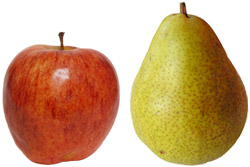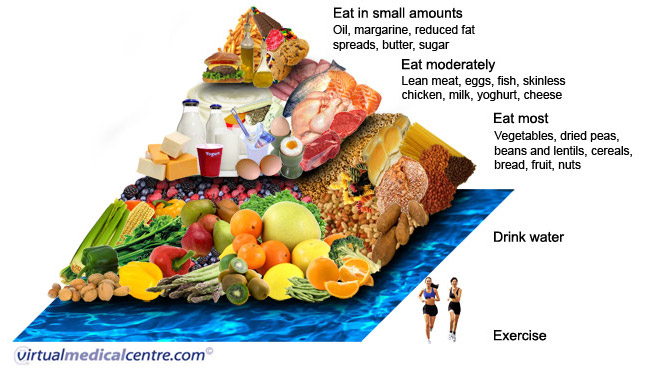Introduction to Nutrition
 Introduction to nutrition
Introduction to nutrition- Why is nutrition important?
- Associated health conditions
- Essential nutrient requirements
Introduction to nutrition
Nutrition is defined as the processes by which an animal or plant takes in and utilises food substances. Essential nutrients include protein, carbohydrate, fat, vitamins, minerals and electrolytes. Normally, 85% of daily energy use is from fat and carbohydrates and 15% from protein. In humans, nutrition is mainly achieved through the process of putting foods into our mouths, chewing and swallowing it. The required amounts of the essential nutrients differ by age and the state of the body, for example: physical activity, diseases present (e.g. prostate cancer, breast cancer or weakened bones – known as osteoporosis), medications, pregnancy and lactation.
Why is nutrition important?
Nutrition is essential for growth and development, health and wellbeing. Eating a healthy diet contributes to preventing future illness and improving quality and length of life. Your nutritional status is the state of your health as determined by what you eat. There are several ways of assessing nutritional status, including anthropometric (i.e. physical body measurement), food intake and biochemical measurement. Your body mass index (BMI) is a good indicator of your nutritional status. It takes into account your weight and height, and correlates well with total body fat expressed as a percentage of body weight. The correlation depends on age, with the highest correlation seen in ages 26–55 years and the lowest in the young and the elderly. If you take your weight in kilograms and divide it by your height in metres squared, the figure you obtain is your BMI.
BMI = height x height (m2)
High values indicate excessive fat stores and low values indicate insufficient fat stores. Your BMI can therefore be used as a diagnostic tool for both over-nutrition and under-nutrition. If your BMI is between 25.0 and 29.9 you are classisfied as overweight. If it is above 30.0, you are classified as obese. The healthy BMI range is 18.5–24.9. However, the BMI is best used together with waist circumference.
This information will be collected for educational purposes, however it will remain anonymous.
- Body builders;
- Some high performance athletes;
- Pregnant women.
- The elderly;
- People with a physical disability who are unable to walk and may have muscle wasting.
 | For more information, see Body Mass Index (BMI). |
BMI and children
The healthy weight range for adults of a BMI of 20 to 25 is not a suitable measure for children.
For adults who have stopped growing, an increase in BMI is usually caused by an increase in body fat. But as children grow, their amount of body fat changes and so will their BMI. For example, BMI usually decreases during the preschool years and then increases into adulthood.
For this reason, a BMI calculation for a child or an adolescent must be compared against age and gender percentile charts. These charts should be used only by health professionals such as your general practitioner, child health nurse, or dietitian.
Body fat distribution and health risk
 A person's waist circumference is a better predictor of health risk than BMI. Having fat around the abdomen or a 'pot belly', regardless of your body size, means you are more likely to develop certain obesity-related health conditions. Fat predominantly deposited around the hips and buttocks doesn't appear to have the same risk. Men, in particular, often deposit weight in the waist region.
A person's waist circumference is a better predictor of health risk than BMI. Having fat around the abdomen or a 'pot belly', regardless of your body size, means you are more likely to develop certain obesity-related health conditions. Fat predominantly deposited around the hips and buttocks doesn't appear to have the same risk. Men, in particular, often deposit weight in the waist region. Studies have shown that the distribution of body fat is associated with an increased prevalence of diabetes, hypertension, high cholesterol and cardiovascular disease.
Generally, the association between health risks and body fat distribution is as follows:
- Least risk – slim (no pot belly);
- Moderate risk – overweight with no pot belly;
- Moderate to high risk – slim with pot belly;
- High risk – overweight with pot belly.
Waist circumference and health risks
Waist circumference can be used to indicate health risk.
For men:
- 94 cm or more – increased risk;
- 102 cm or more – substantially increased risk.
- 80 cm or more – increased risk;
- 88 cm or more – substantially increased risk.
When there is an imbalance between your nutrient requirements and your intake, malnutrition sets in. There are two forms of malnutrition – under-nutrition and over-nutrition. Over-nutrition is common in many developed countries, including Australia.
 | For more information, see Waist Circumference (WC). |
Associated health conditions
Dietary factors are associated with some leading causes of death, such as:- Coronary heart disease;
- Some types of cancer;
- Stroke;
- Type 2 diabetes mellitus.
Essential nutrient requirements
Nutrients can be described as the chemical components of food and can be classified into six broad groups: carbohydrates, proteins, fats, vitamins, minerals and water. Water is not technically a nutrient, but it is essential for the utilisation of nutrients. Nutrients perform various functions in our bodies, including energy provision and maintaining vital processes such as digestion, breathing, growth and development.Energy balance
Your energy requirement depends on your age, size and activity level. If your energy intake equals the amount of energy you expend, then you are in energy balance. If your intake exceeds your expenditure, the excess energy is converted to body fat and you gain weight. On the other hand, if your intake is less than your expenditure, your body uses up fat stores and you lose weight. Therefore, for weight to remain stable, the total amount of calories that are consumed must not exceed the total that is used up through metabolic processes (e.g. exercising, sweating, breathing). Energy intake must match energy output. The average energy intake is about 2800 kcal/day for men and 1800 kcal/day for women, although this varies with body size and activity level.
| Calorie Counter |
| Calculate your daily calorie intake and compare it to your recommended daily intake. Click here to complete the Calorie Counter |
Carbohydrates
Carbohydrates can be classified as monosaccharide (e.g. glucose, fructose, galactose), disaccharide (e.g. sucrose, lactose, maltose) and polysaccharide (e.g. starch, fibre). Carbohydrates must be reduced to the simplest form of glucose (through digestion) before your body can make use of them. Carbohydrates should make up at least 55% of your total energy intake. The brain is a special part of the body that depends primarily on glucose for its energy and requires about 100 g/day of glucose for fuel. In some situations, the body can compensate for decreased levels of carbohydrates by using alternative energy pathways such as burning fatty acids.
Protein
Protein is important for the production, maintenance and repair of tissues in the body. When energy intake is insufficient, protein intake must be raised. This is because ingested proteins are preferentially directed towards glucose (sugar) synthesis and oxidation. The tissues and organs in the body are made up of protein and protein compounds. Enzymes (biological catalysts), antibodies and hormones also consist of protein. The building blocks of protein are called amino acids. The body can make all of the 20 amino acids except eight, which are termed essential amino acids. These are isoleucine, leucine, lysine, methionine, phenylalanine, threonine, tryptophan and valine. Histidine is essential only for infants. The number and nature of amino acids present in a particular protein determines that protein's characteristics.
For adults, the recommended dietary allowance of protein is about 0.75 g/kg body weight per day. Animal products tend to have the highest amount of proteins, followed by legumes (beans), cereals (rice, wheat, corn) and roots. Animal protein (from meat, eggs, fish, milk) contains all the essential amino acids and is normally referred to as 'complete' or 'high biological value' protein. Protein derived from plants lack one or two essential amino acids. However, a good combination of plant-based protein can be of equal value to animal protein. For example, legumes lack methionine but have adequate amounts of lysine. Cereals, on the other hand, lack lysine but have a lot of methionine. Therefore, a mixture of rice and beans will supply all the essential amino acids.
Excess protein cannot be stored in the body, so we need to consume protein daily. Consuming too much protein is not recommended because it promotes increased calcium excretion through urine, which increases the risk of developing osteoporosis. Additionally, too much protein intake may lead to a greater concentration of the amino acid homocysteine in the blood, and the subsequent conversion to thiolactone. Thiolactone is associated with increased levels of atherosclerosis and endothelial damage.
Fats and oils
 Most of the fats we consume occur in foods as triglycerides. A triglyceride is comprised of three fatty acid molecules attached to a glycerol molecule. Fatty acids are made up of carbon and hydrogen atoms and can be either saturated or unsaturated. Saturated fatty acids (SFA) have the maximum number of hydrogen atoms attached to the carbon chain, while unsaturated fatty acids have less than the required hydrogen atoms. For example, monounsaturated fatty acids (e.g. oleic acid) have two hydrogen atoms missing. Monounsaturated fats are found mainly in nuts, avocados, olive oil, canola oil, grapeseed oil, peanut oil, flaxseed oil, sesame oil, corn oil, safflower oil, sunflower oil, etc.
Most of the fats we consume occur in foods as triglycerides. A triglyceride is comprised of three fatty acid molecules attached to a glycerol molecule. Fatty acids are made up of carbon and hydrogen atoms and can be either saturated or unsaturated. Saturated fatty acids (SFA) have the maximum number of hydrogen atoms attached to the carbon chain, while unsaturated fatty acids have less than the required hydrogen atoms. For example, monounsaturated fatty acids (e.g. oleic acid) have two hydrogen atoms missing. Monounsaturated fats are found mainly in nuts, avocados, olive oil, canola oil, grapeseed oil, peanut oil, flaxseed oil, sesame oil, corn oil, safflower oil, sunflower oil, etc. Polyunsaturated fatty acids (PUFA) have more than two hydrogen atoms missing (e.g. linoleic acid and linolenic acid). Linoleic and linolenic acids are regarded as essential fatty acids (EFAs) because the body cannot make them. There are two categories of EFAs: omega-3 and omega-6. The number that comes after "omega-" represents the position of the first double bond, counting from the terminal methyl group on the molecule. Omega-3 fatty acids are derived from linolenic acid and omega-6 from linoleic acid. Alpha linolenic acid (ALA) is converted into eicosapentaenoic acid (EPA), and later into docosahexaenoic acid (DHA) in the body. Sources of omega-3 fats include salmon, mackerel, sardines, anchovies, tuna, flaxseed oil, walnuts, etc. Sources of omega-6 fats include palm oil, soybean oil, canola oil, sunflower oil, nuts, etc. Evidence from research indicates that omega-3 fatty acids reduce inflammation and help prevent certain chronic diseases such as heart disease and arthritis. Omega-3 fatty acids are highly concentrated in the brain and appear to be crucial to brain function as well as normal growth and development. Infants who do not get enough omega-3 fatty acids from their mothers during pregnancy are at risk of mental impairment.
Generally, saturated fatty acids raise blood cholesterol levels, whereas unsaturated fatty acids lower them. Saturated fats are found in foods such as butter, meat and dairy fats. Trans fats are artificially created during food processing. In the body, trans fats act in a similar way to saturated fats and may raise cholesterol levels. These fats are considered to be harmful to your health. Trans fats are found mainly in deep-fried fast foods and processed foods made with margarine.
Fats are a concentrated and rich source of energy. It is recommended that your total fat intake is no more than 30% of your energy (calorie/kilojoule) intake. Polyunsaturated fat should be less than 10% of energy, and saturated fat and trans fat together should be less than 10%. The rest of your fat intake should consist of monounsaturated fat.
Vitamins
Vitamins constitute a group of nutrients that are needed in small quantities. Like amino and fatty acids, most vitamins cannot be made in the body and must be obtained from dietary sources. Only vitamin D can be manufactured by the body. Essential vitamins are grouped into two families: water soluble and fat soluble. Water soluble vitamins can dissolve in water (thiamine, riboflavin, niacin, vitamin C, folic acid). These cannot be stored by the body and need to be consumed every day. Fat soluble vitamins can dissolve in a fat medium (vitamins A, D, E, K). These are taken into our bodies when we consume fat-containing foods. Vitamins are needed for various reasons, including the formation of hormones and blood cells. They generally act as coenzymes. An inadequate supply of vitamins in our diet leads to the development of diseases.
- Vitamin A: Derived from carotene, vitamin A affects vision, reproduction, and the formation and maintenance of skin, mucous membranes, bones and teeth. Deficiency results in night blindness (difficulty in adapting to darkness). The body obtains vitamin A from either carotene (vitamin A precursor) or by absorbing ready-made vitamin A from plant-eating organisms. Carotene is found in dark green leafy vegetables and yellow-orange fruit/vegetables. Pre formed vitamin A is found in milk, butter, cheese, egg yolk, liver, and fish-liver oil.
- Vitamin B complex: The vitamin B complex is a mixture of eight essential vitamins necessary to enhance immune and nervous system function, and promote cell growth and division. Pregnant or lactating women, alcoholics and the elderly are more likely to suffer from vitamin B deficiency.
- Vitamin B1 (thiamine): Thiamine, or vitamin B1, acts as a catalyst in carbohydrate metabolism. Thiamine deficiency causes beriberi, a vitamin deficiency disorder characterised by muscular weakness, swelling of the heart and leg cramps. In severe cases, beriberi may lead to heart failure and death. The richest dietary sources of thiamine are pork, organ meats (liver, heart, and kidney), brewer's yeast, lean meats, eggs, leafy green vegetables, whole or enriched cereals, wheat germ, berries, nuts, and legumes.
- Vitamin B2 (riboflavin): Riboflavin, or vitamin B2, acts as a coenzyme in the metabolism of carbohydrates, fats, and respiratory proteins. The best sources of riboflavin are liver, milk, meat, dark green vegetables, whole grain and enriched cereals, pasta, bread and mushrooms.
- Vitamin B6 (pyroxidine): Pyridoxine, or vitamin B6, is necessary for the absorption and metabolism of amino acids. It also plays a role in the body's use of fats and in the formation of red blood cells. The best sources of pyridoxine are whole grains, cereals, bread, liver, avocados, spinach, green beans and bananas.
- Folic acid (vitamin B9 or folacin): Folic acid is a coenzyme needed for forming body protein and haemoglobin. Folic acid deficiency is associated with neural tube defects. Dietary sources are organ meats, leafy green vegetables, legumes, nuts, whole grains and brewer's yeast. Folic acid is lost in foods stored at room temperature and during cooking.
Minerals
Minerals are essential, acting as cofactors of enzymes (i.e. enzymes would not exist or function without minerals). Some of the minerals necessary for health are:
- Calcium: Calcium is a very important mineral in the diet, especially for women at menopause. The major function of calcium is to build and help maintain strong bones. It can stop the onset of osteoporosis and reduce bone loss and fragility. It is involved in blood clotting. Calcium deficiency can develop when there is a lack of vitamin D.
- Iron: Iron in food exists as haem and non-haem iron. Haem iron, found in red meat, is relatively well (20–30%) absorbed. Non-haem iron, found mostly in cereals, pulses, certain vegetables (e.g. spinach) and eggs, is generally less well absorbed. Non-haem iron absorption depends on other factors in the diet. For example, vitamin C and animal protein enhance non-haem iron absorption, while tea, coffee and phytates inhibit it.
- Zinc: Zinc represents only 0.003% of the human body, but is essential for synthesising protein, DNA and RNA. It is required for growth in all stages of life. Sources include meats, oysters and other seafood, milk, and egg yolk.
Calcium Intake Calculator
How much calcium do you consume?
 | Calcium is found in many foods, in particular dairy products and to a lesser degree bony fish, nuts and legumes, fruit and vegetables. It plays an important role in building and maintaining healthy bones and teeth. Individuals need to consume sufficient amounts of calcium throughout their lifespan. Calcium requirements increase throughout childhood, peak during puberty, then stabilise until an individual is approximately 50 years old, when bone mass deteriorates and more calcium is required. |
Water
For adults, 1–1.5 mL water per kcal of energy expenditure is usually sufficient to allow for normal changes in physical activity, sweating, and dietary solute load. Water losses consist of 50–100 mL/day through faeces (stools), 500–1000 mL/day by evaporation, and approximately 1000 mL/day through urine. If external losses increase, we must increase the amount of water we ingest. In special circumstances such as diarrhoea and vomiting, water requirements further increase.
Balanced diet
Virtual Medical Centre Video
 Watch a video on Dietary Changes for a Healthier Lifestyle
Watch a video on Dietary Changes for a Healthier LifestyleA healthy diet consists mainly of plant foods (e.g. fruits and vegetables, potatoes, cereals, etc.) and moderate amounts of animal products (e.g. milk, fish, lean red meat and poultry). Fats and oils should normally provide less than 30% of our energy, and less than 10% of this should be saturated fat. Lean red meat, poultry and fish, eggs and dairy foods are rich sources of animal protein. Dairy foods, apart from supplying quality protein, are good sources of calcium. Good vegetable sources of protein include legumes (e.g. peanuts, lentils, kidney beans), soya products (e.g. tofu), grains, nuts and seeds.
Healthy eating pyramid
The food pyramid is a simple practical guide to selecting varied foods for meals. The Australian Nutrition Foundation Inc. (Nutrition Australia) has developed its own food pyramid. The rationale behind the food pyramid emphasises the need to include generous amounts of plant-based foods (cereals, legumes, fruits and vegetables) and moderate amounts of animal products (meat, fish, milk, eggs) in our diets. Furthermore, our diet should contain only small amounts of energy-dense foods (e.g. sugar, fats and oils). The base of the pyramid (plant-based foods) is broad, and the top (animal products) is narrow. Eating according to the structure of the food pyramid ensures we consume a healthy diet. With care the food pyramid can also assist vegetarians and vegans to consume a nutritionally balanced diet, although some people will require dietary supplements (e.g. vegans will require vitamin B12).
Glycaemic index and glycaemic load
Carbohydrates should make up at least 55% of our total daily energy intake. The quality and quantity of these carbohydrates are important in blood sugar and appetite control. After you consume carbohydrate-containing foods, your pancreas secretes insulin to break the carbohydrates down into their building blocks. Insulin acts to lower blood glucose levels. When your blood glucose levels decrease to a particular level, your brain is sent a signal and you become hungry again. Even though different foods may contain the same amounts of carbohydrate, their effects on blood glucose control may be very different. This has lead to the development of measures such as the glycaemic index (GI) and glycaemic load (GL) of a food product. The concept of GI was formulated by Jenkins and colleagues in 1984. They found that blood glucose response to carbohydrate foods is independent of the amount of carbohydrates they contain. The limitation of the GI lies in the difficulty of translating the concept into practice, since the glycaemic effect of foods is not constant and can vary depending on the way the food is cooked.
Low GI and GL foods have been shown to be associated with health advantages such as decreased blood sugar levels. Foods with a low GI (less than 55) cause a slower and lower rise in blood glucose levels. These include breads such as mixed-grain and oat breads, barley, pasta, noodles, beans, sweet potatoes, green peas and milk. Foods with a high GI (greater than 70) cause a faster and higher rise in blood glucose levels. High GI foods include white bread, steamed white rice and chips.
By incorporating low GI foods into your diet, you will bring down the average GI of your meal, have a lower, slower blood sugar response to the meal and feel 'full' for longer. By consuming low GI foods, you are more likely to be satisfied and feel full for longer periods of time. This helps you to maintain a healthy weight and avoid diseases such as heart disease, diabetes and some cancers.
 | For more information, see Glycaemic Index (GI) and Glycaemic Load (GL). |
Tips for healthy eating
Some tips for maintaining a healthy diet and incorporating the GI index into your daily routine include: - Follow the Dietary Guidelines for Australians and try to incorporate a variety of foods into your eating plan.
- Try to use low GI foods instead of high GI foods when possible.
- Try to have one low GI food at each meal.
More information
 | For more information on nutrition, including information on types and composition of food, nutrition and people, conditions related to nutrition, and diets and recipes, as well as some useful videos and tools, see Nutrition. |
Article kindly reviewed by:
The DAA WA Oncology Interest Group
and
Food4Health (Helen Baker Dietitian-APD)
Reference
- Dwyer J. Harrisons Principles of Internal Medicine; Nutritional Requirements and Dietary Assessment. USA: The McGraw-Hill Companies; 2006.
- Symmonds EM, Symmonds IM. Essential Obstetrics & Gynaecology. Spain: Churchill Livingstone; 2004.
- National Womens Health Centre, Nutrition.
- Deurenberg P, Westrate JA, Seidell JC. Body mass index as a measure of body fatness: age and sex prediction formulas. Brit J Nutr. 1991; 65: 105-14.
- NSW Health, Nutrition & Pain, Community Information Series, Hunter Integrated Pain Service; 2005.
- Nutrition Australia. Healthy Eating Pyramid. Australia: Retrieved from: www.nutritionaustralia.org, 1999.
- Augustin L, Franceschi S, Jenkins D, et al. Glycemic index in chronic disease: a review. European Journal of Clinical Nutrition. 2002; 56: 1049-71.

Very informative post! I've learned a lot. Thanks for sharing
ReplyDeletepediatric emr